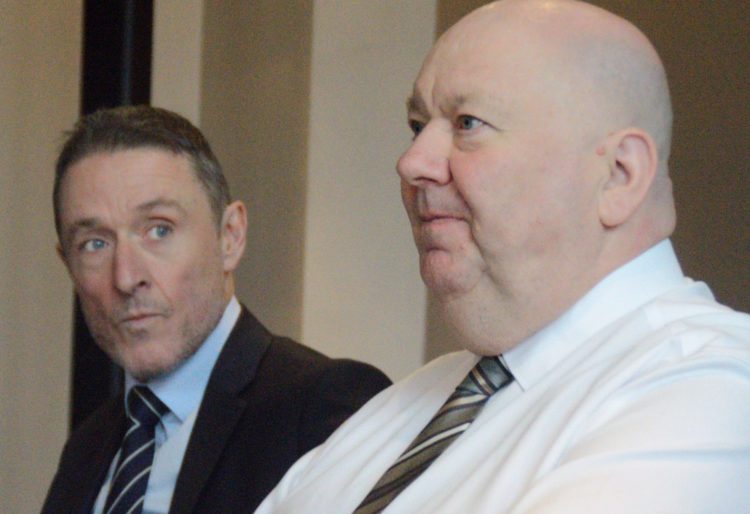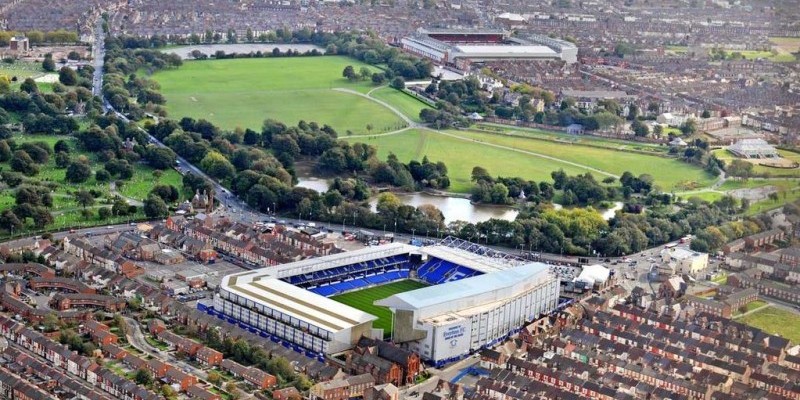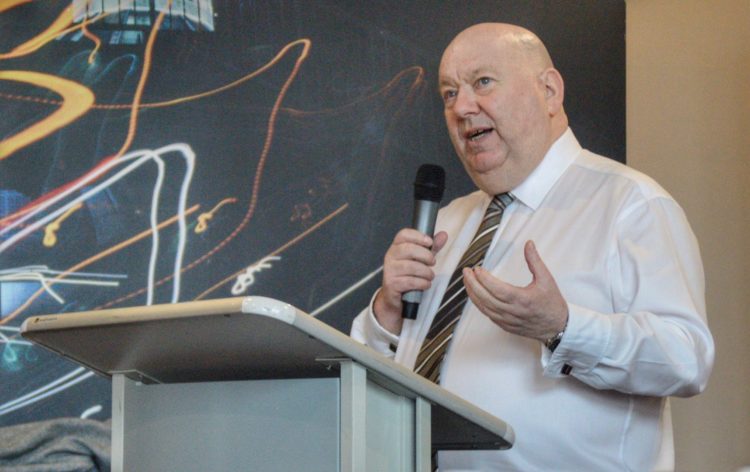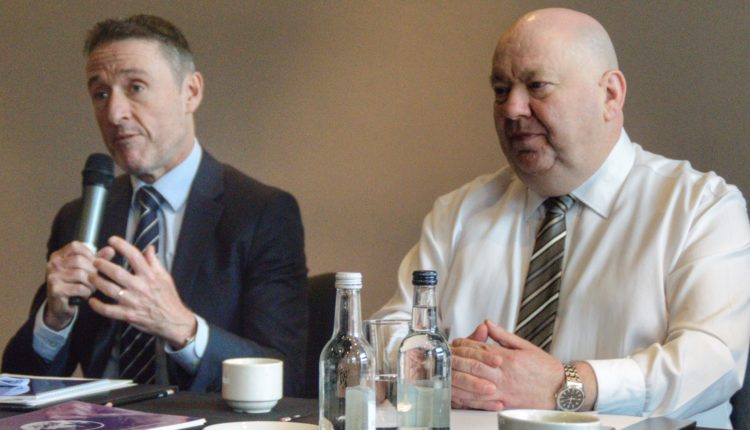Blues are aiming to start work on the ‘intimidating’ new arena in Liverpool’s docklands in summer 2019 with the ground being ready in time for the 2022/23 season in what the club admits is an ‘ambitious’ timescale. Tony McDonough reports

Everton FC chief executive Robert Elstone has admitted securing the finance to build its new £500m stadium in Liverpool’s docklands will “not be easy”.
But Mr Elstone insisted he and his team were forging ahead with their plans to begin work on the stadium at Bramley Moore Dock in summer 2019 and have it ready for use in August 2022 – and promised an arena that would be “intimidating” for opponents.
Mr Elstone was speaking on a platform with Liverpool Mayor Joe Anderson at the city’s Malmaison hotel, at a private breakfast event organised for members of Liverpool-based business lobby group Downtown in Business.
Finance deal
Mayor Anderson has proposed a deal whereby the city would borrow £280m at ultra-low interest rates and then pass on the loan to Everton who would repay it at a higher interest rate over 25 years – netting the council an estimated £7m-a-year profit.
And the Mayor insisted such deals were not just desirable for the city – but essential – if it was to generate extra income for key services in the face of ongoing cuts to its budget from central Government.
That agreement still leaves Everton with more than £200m to find to get the project under way and Mr Elstone admitted: “The project has seen a significant increase in costs but with ambition comes cost. We need to maintain a careful management and control of those costs.
“The next important issue is how do we find the additional funding. That will not be easy and we are currently looking at a number of funding solutions.”
Capacity question
Premier League rivals such as Liverpool and Arsenal have redeveloped or moved to new stadia in recent years with the primary aim of increasing capacity. Arsenal’s move from Highbury to the Emirates saw an increase in capacity of more than 20,000 to almost 60,000.
Everton’s current home Goodison Park holds just under 40,000 people and, within that, the club has to accommodate its 35,000 season ticket holders.
Mr Elstone said the capacity of Bramley Moore had yet to be decided but said people should not expect a massive leap and said the main focus was less on extra capacity and more on the quality of the arena and the atmosphere it would generate on matchdays.

At Anfield legendary Liverpool manager Bill Shankly successfully created a “bastion of invincibility” and Mr Elstone said he wants Everton’s new arena to become a “fortress” at which only Everton’s players will enjoy playing.
“We are now looking at the design of the stadium and we have been getting a lot of feedback from the fans and we have been formalising that in recent weeks,” he explained.
“As part of the planning process we have been visiting stadia all over the world and we have been aware of what our fans have been telling us. Our new stadium will need to be tight, intimate and intimidating – we are looking to create a fortress.”
Business case
He also admitted the business case for the new arena was “tight”, playing down expectations of huge extra revenues.
“The business case for the new stadium is more about future-proofing the club,” he said. “We haven’t yet decided on the capacity for the new stadium but is it not going to be a massive increment.
“The business case is strong. Goodison’s issue isn’t capacity – it is about the age of the seats and the concourse. There will be a big increase in corporate seating but by the time we have paid for everything it will not be a silver bullet. The business case is tight.”
And Mr Elstone also insisted the main priority was always to make sure there was enough money in the pot to ensure the team could compete on the pitch, adding: “Every place in the Premier League is worth an extra £2m a year… the profits we make will be invested in players’ transfers and players’ wages.
“Last week we held a commercial workshop at the club to talk about how much the new stadium will bring to us financially. Next we need to prepare a planning application and we are working closely with our advisors CBRE on that and in all there is a lot of progress being made.”
Relegation fear
The loan deal with the city, still subject to full council approval, has been met with scepticism by opposition councillors as well as many council tax payers. One of the big questions raised has been if Everton were relegated from the Premier League, would it be able to meet the loan repayments?
Last year, Everton earned £130m through the Premier League TV rights deal. Even the most successful teams in the EFL Championship earn a fraction of that. Relegation would see Everton receive a “parachute payment” currently worth around £90m over three seasons.
Elstone gave little detail away when pressed on what contingencies were in place to repay the loan should Everton be relegated other than to insist such an eventuality was fully factored in and that the deal still made sense for both parties.
He said: “Joe (Anderson) and his team of advisors have been looking at every eventuality. They have had advice on that and they would not do anything that would put the city at risk.”
Mr Anderson echoed that comment, adding: “The deal will be absolutely clear, transparent and open. There is now way we would do it if the risk was too high.”
‘Invest to earn’
The Mayor went on to talk about how the Everton project was part of the council’s wider “invest to earn” strategy that he claimed was essential if the city was to maintain its vital services.
Going back a year ago the plan was for Everton to raise all the money for the stadium itself with the council acting as guarantor. But Mayor Anderson said there was little profit in it for the council hence the new proposed deal.
And he repeated his claim that the new stadium, which it is claimed will act as a catalyst for regeneration schemes such as Liverpool Waters and Ten Streets, was as important to the city as the £1bn Liverpool One leisure and retail development had been 10 years earlier.

He explained: “by 2020 we will lose the revenue support grants from the Government and we will have to rely on council tax and business rates for our essential services. This means the public sector has to bring in extra revenue.
“Over the past few years we have earned an extra £28m for the city through our invest to earn strategy.”
Financial benefits
He cited examples of where council investment and support for commercial projects had reaped either direct or indirect financial benefits for the city, including ACC Liverpool, the purchase of Everton’s former Bellefield training complex, the Titanic Hotel and the purchase of the waterfront Cunard Building, which was now the council’s headquarters.
Mr Anderson added: “There is no new money coming from the Government so we have to look at how we can do things differently. We want to get the city’s population from where it currently is at under 500,000 to the million people it was built for.
“If you look at the effects of the proposed deal with Everton – we are already seeing a big rise in land values around the Ten Streets area with the first planning application due to go in shortly.
“People ask me ‘why are we engaging with Everton FC and its billionaire owner?’. The fact is the finance on this stacks up so my answer is ‘why wouldn’t we?’”

